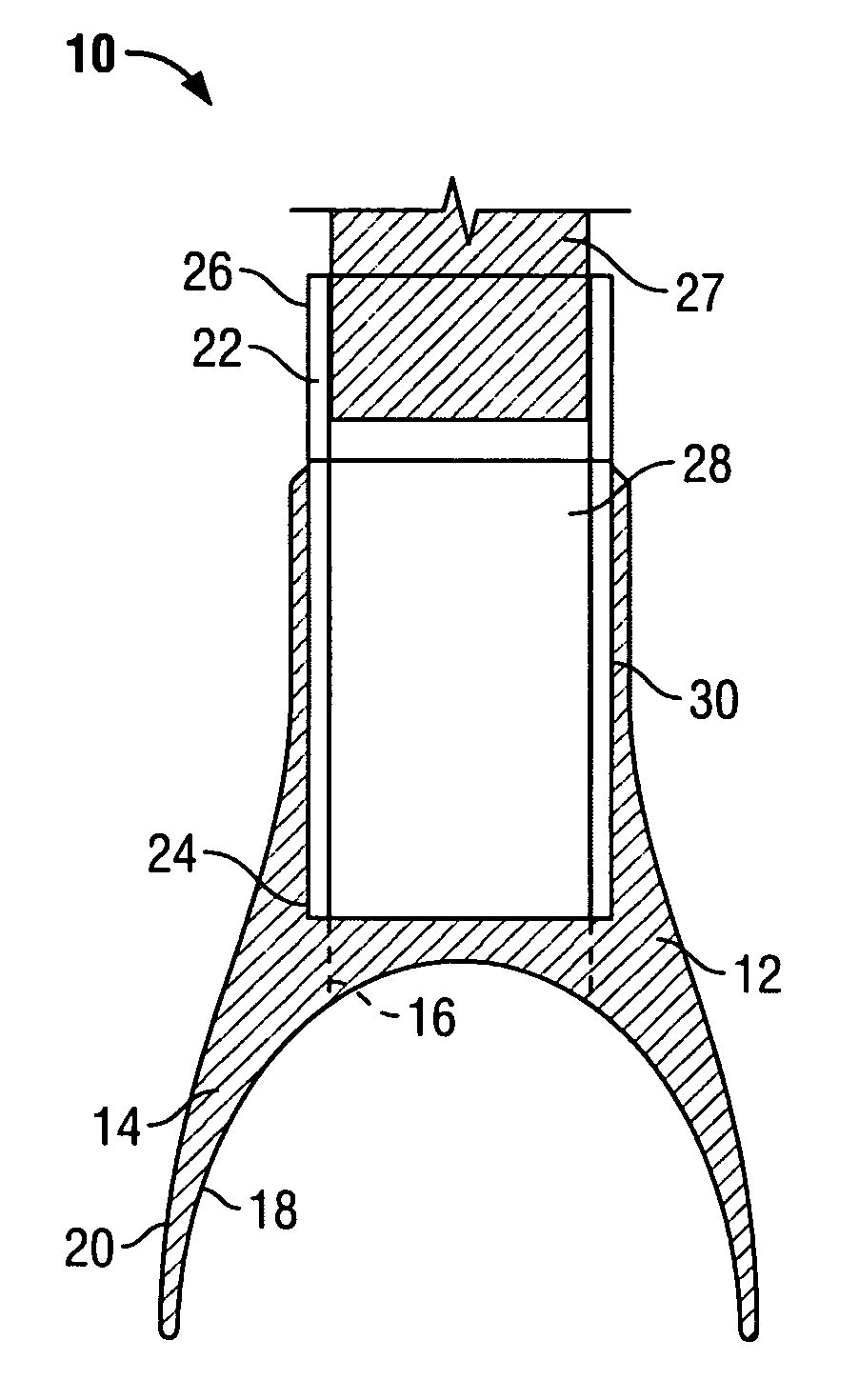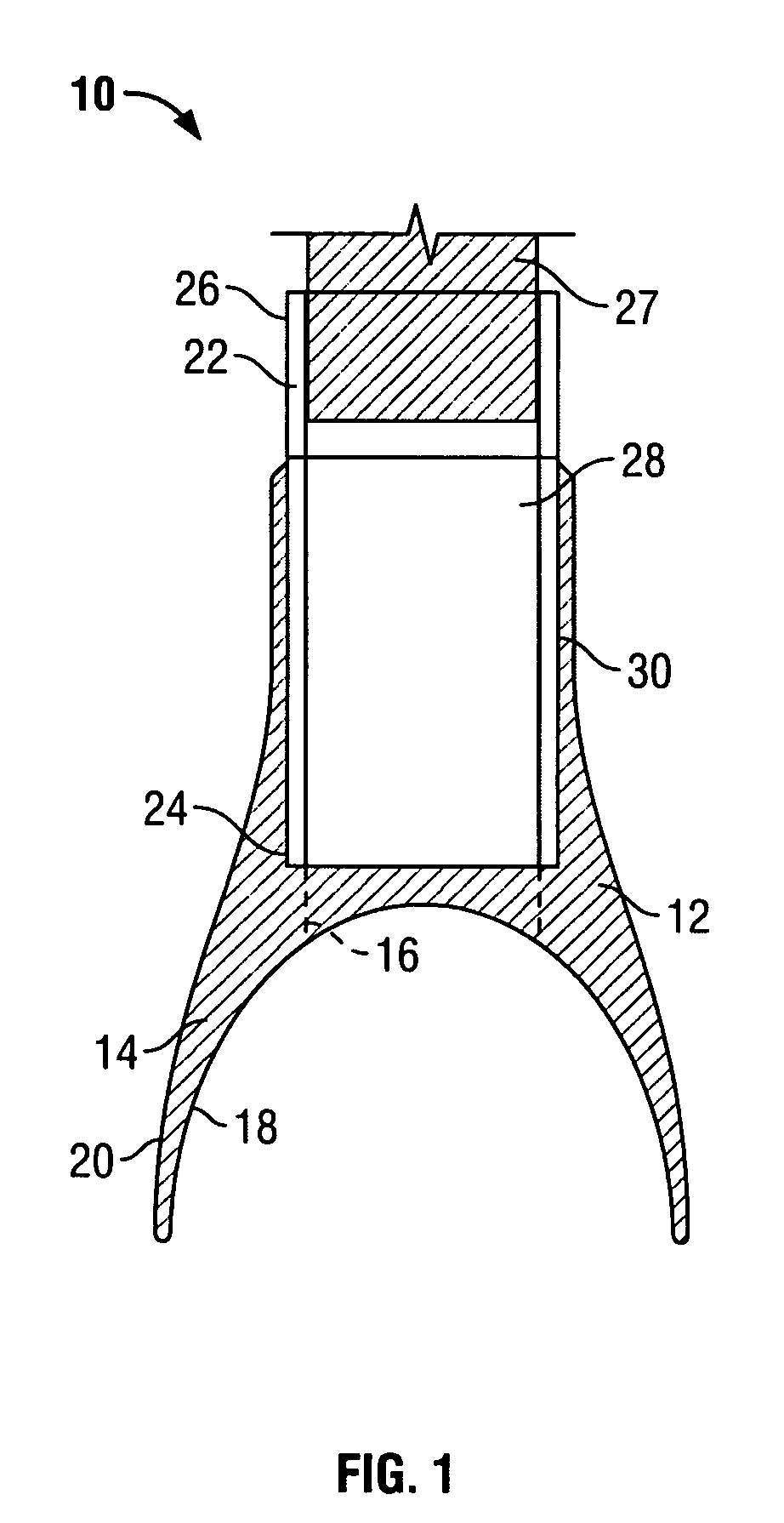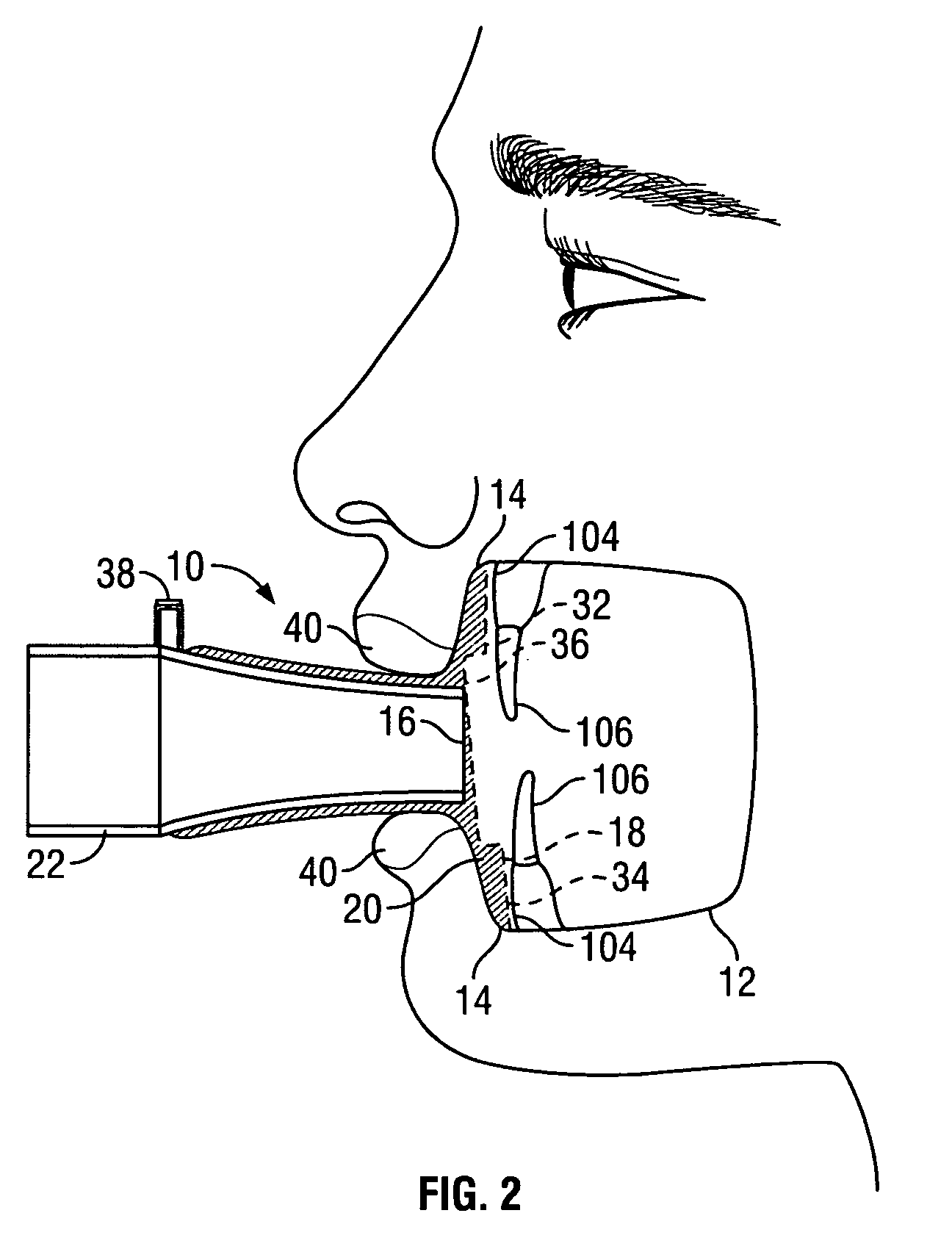This need for access to several different sized masks is particularly burdensome to emergency medical technicians who must transport medical supplies in a limited amount of space.
Perhaps the largest shortcoming of the traditional sized respiratory masks is that despite the availability of several sizes of mask, the wide variations in facial features among people prevent these masks from sealing effectively.
Where the person to be ventilated has
facial hair, traditional respiratory masks are almost completely incapable of forming a seal with the person's face.
This deficient sealing causes leakage around the edges of the mask and significantly decreased gas
delivery efficiency.
An inherent problem with traditional respiratory masks that contributes to gas leakage is that the gas must pass from the mask through the lips and teeth of the person being ventilated before being received in the person's mouth, or it must pass through the
nose of the person being ventilated.
Such an arrangement is highly disadvantageous for long term ventilation of a person, such as occurs when a patient is transported or under
anesthesia in an operating room.
The application of excessive pressure by the healthcare provider on a traditional respiratory mask is problematic for several reasons.
The pressure required to be applied for proper sealing of the face mask can quickly lead to healthcare provider fatigue.
A fatigued healthcare provider may be less able to apply sufficient pressure onto the traditional respiratory mask to reduce its inherent leakage and may have difficulty performing this and other critical tasks.
Additionally, the application of excessive pressure to a traditional respiratory mask onto the face of the person being ventilated will cause the mask to develop pressure points on the bridge of the
nose,
cheek bones, and
chin.
This pressure could lead to
irritation of wearer's face and discomfort or pain to the wearer.
These tasks, in addition to the above task of preventing leaks can overwhelm the healthcare provider and often require two providers to ventilate a patient adequately.
Squeezing the bag with maximal intensity in an attempt to compensate for deficient sealing of a traditional respiratory mask is likewise problematic.
The increased inspiratory forces may exceed the opening pressure of the
esophagus, possibly leading to esophageal and gastric dilatation and subsequent aspiration.
Their attempted solutions, however, have fallen far short of addressing all of the problems of the traditional respiratory mask and have created new problems.
Nevertheless, despite these advantages over the traditional respiratory masks, the integration of a
bite block into the design creates several disadvantages.
Mouthpieces having bite blocks or
bite plates cannot be safely inserted into the mouth of someone who is combative, semiconscious, or having a seizure.
A healthcare provider attempting to insert a
mouthpiece with a bite plate by prying open the jaws of a person to be ventilated would do so at risk of sustaining bite related injuries, possibly as severe as
amputation of a digit or contracting an infectious
disease.
Forced
insertion of a mouthpiece with
bite block into the mouth of a person to be ventilated also risks the person's aspiration of blood, teeth, dental fragments, or fragments of the
bite block broken off during
insertion.
Another
disadvantage of mouthpieces with bite blocks is that their wearers will reflexively bite down and typically they may not be worn by persons with missing teeth,
dentures, or those with facial injuries, jaw trauma or fractures.
Further, because people wearing mouthpieces with bite blocks will bite down on the blocks, the use of these mouthpieces can quickly lead to jaw fatigue and discomfort.
These bite blocks may also stimulate a gag
reflex and increase the aspiration risks in the awake or semiconscious patient.
If the
oropharyngeal airway is to be integrated with the mouthpiece, it would be impossible for the
airway to be inserted with a 180°
rotation method as the bite block would collide with the teeth of the person to be ventilated.
Therefore, the integration of a mouthpiece with a bite block is also undesirable.
Additionally, while intraoral mouthpieces with incorporated bite blocks address the problem of gas delivery to the mouth of a person, they can create gas leakage through the nose of the person to be ventilated.
The prior art respiratory devices having intraoral mouthpieces with bite blocks deliver gas to the mouth of a person to be ventilated without providing for sealing the nose of the person to be ventilated.
While the respiratory mouthpieces with bite blocks do address several problems of the traditional respiratory mask, the bite blocks make these devices impossible to use on certain individuals (with
dentures, missing teeth, or facial / jaw trauma), dangerous to use on others (combative or semiconscious), and uncomfortable to use on everyone.
Moreover, since prior art intraoral mouthpieces with bite blocks do not address gas leakage from the nose of the person to be ventilated, they are still inefficient gas delivery devices.
Lastly, none of the mouthpieces with bite blocks can accommodate typical oropharyngeal airways.
But, these attempts also create problems.
The flanged mouthpiece, while likely an improvement over the traditional respiratory mask, has serious wear and comfort issues.
Therefore, while the flanged end of the device provides a seal between the material of the flanged end and the inside of the lips and gums of the person to be ventilated, that seal still leaves avenues for gas leakage.
This limited sealing area will result in a pressure concentration,
irritation, and discomfort on the gums of the person to be ventilated, possibly leading to lacerations and bleeding.
Therefore, while the flanged conduit respiratory device is an attempt to address the problems of the traditional respiratory mask, it suffers the disadvantages of inadequate intraoral sealing due to a small seal surface area and gum
irritation or injury to the wearer.
Further, there is no nasal occlusive component and the device is incompatible with an
oropharyngeal airway.
In addition, the
inflatable seal may cause pressure points and irritate the gum and mucosa of the wearer.
The
inflatable seal approach is also undesirably complex, requiring inflation of both an intraoral seal and a separate nasal block before use, and this complexity necessitates several component elements that are in danger of being bitten off and rendered ineffective by a combative or semi-conscious person.
Time, which is very limited in a critical or emergent
resuscitation, is also required to inflate both the intraoral seal and the nasal block.
This device is also incompatible with current oropharyngeal airways.
 Login to View More
Login to View More  Login to View More
Login to View More 


